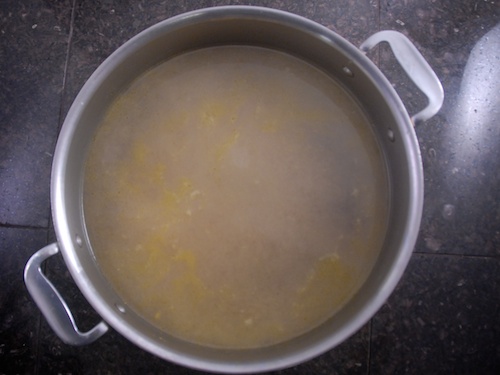
fresh vegetables and herbs for vegetable stock
A base of this richly flavorful stock makes soups, stew, or rice dishes shine. I cook up a batch before winter holidays to use in wild rice stuffing, and at other times for soups and stews. The yield is about 10 cups, enough to save at least half in the freezer. It’s like gold in there, ready to pull out when I want to make a great meal.
Why not just buy boxed broth? By making your own, you’ll save a little money while creating something that’s absolutely fresh and full of nutrients from a large quantity of vegetables. The stock won’t be too salty, have questionable ingredients, or create packaging waste. I figured I saved about $5 to $7 buying organic vegetables for this recipe instead of buying boxed organic stock. The best reason to make this yourself is one I can’t really convey in a post. If you could smell this on the stove from where you are, you’d know what I mean.
Some people keep vegetable trimmings in a bag in the freezer for making stock. It wouldn’t be hard to collect potato peels, celery leaves, and parsley stems, though you will want the ingredients to be fresh. Even without using trimmings, this recipe is inexpensive, especially if you simplify and stick to the three vegetables that are used to make stock in French cooking: a mixture of two parts onion to one part each of carrots, and celery, called mirepoix.
You can certainly add extra vegetables, but be aware that some, like the brassicas (broccoli, cabbage) don’t taste good in stock. And others, like mushrooms, give it a really assertive flavor. Not necessarily a bad thing, but the stock will no longer be a neutral base you can use for anything. I’ve made this without the leeks, and it’s a bit simpler and tastes fine, but they really do add something, I recommend them.
Making stock is not hard, but the process takes a while, which is why I make it when I have spare time, not in the middle of other cooking tasks. See my post on how to trim and clean leeks if you haven’t cooked with them before. Chop the onions, carrots, celery, and leeks with a freshly sharpened chef’s knife or the slicing wheel of a food processor. Put the chopped veggies in your biggest stockpot and saute them over a medium-low flame for ten or fifteen minutes. If you prefer not to use any added oil, the stock will still be good if you skip this step. But some flavors are fat-soluble, so if you just cook the vegetables in water, those flavors won’t be released.

vegetables for the stock, sauteed
Next you add water and go off and do something else while the broth simmers for an hour.
I first learned how to make vegetable stock from Jack Bishop’s very useful The Complete Italian Vegetarian Cookbook Cookbook, and my recipe is still based on his. He calls for pouring the stock through a fine-mesh strainer at the end, then pressing on the vegetables to remove as much liquid as possible. I pour the stock through a strainer, but find trying to press the liquid out of the vegetables frustrating. So I put them in a sturdy cloth instead and twist, which gets out lots of liquid and flavor.
Here the stock is ready to pour through a strainer to separate out the vegetables:

ready to pour the stock through a strainer.
Next, the vegetables in a cheesecloth ready to squeeze out the rest of the liquid:

straining the stock in a piece of cheesecloth
Stock squeezed through a clean cloth, on the left, vs. stock that’s simply been drained on the right. The extra time to put the stock through the cheesecloth is worth it, yielding a much richer stock:

the difference between stock squeezed through a cloth and stock drained through a strainer
And the final result:

the finished vegetable stock
Here’s a video on making vegetable stock. It omits the step of pressing the vegetables or twisting them in a cloth, and it includes white wine. The wine would be good in theory, but I rarely have an open bottle handy.
And the vegetable stock recipe:
- 1 # leeks (1 large or 2 medium to small)
- 1# yellow onions (2 medium)
- 6 oz. celery stalks with leaves on, or leaves and inner stalks from 2 bunches of celery
- 6 oz. carrots or 4 small carrots
- 2 T olive oil
- 12 cups water
- 16 sprigs of Italian parsley or a larger number of parsley stems
- peelings from 2 large or 4 small potatoes
- 4 garlic cloves, mashed a bit with the side of a knife but unpeeled
- 4 bay leaves
- 2 tsp. black peppercorns
- small bunch fresh thyme (10 stalks)
- Wash leeks (see separate post on this if you haven't done it before- dirt often hides between the outer layers of the stalk). Trim off the dark green leaves. Cut off the roots.
- To chop the vegetables, use either a freshly sharpened chef's knife or the grating wheel of a food processor. Since the vegetables will ultimately be discarded and don't need to be cut attractively, this would be a good time to use a food processor.
- Chop the white part of the leeks.
- Peel and chop carrots.
- Peel and chop onion.
- Chop celery stalks and leaves.
- Add 2 Tsp. olive oil to a large stockpot, heat on a medium-low flame, add the above vegetables. Let the vegetables 'sweat' (cooking but not browning) for 10 to 15 minutes, stirring occasionally.
- Add 12 cups water to the pot and the parsley, potato peels, garlic cloves, bay leaves, peppercorns, and thyme.
- Bring to a boil, then simmer for one hour.
- Place a strainer over another large pot.
- Pour the stock through a strainer to separate the liquid from the cooked vegetables, collecting the stock in the pot below.
- Put the stock in a cheesecloth or other fine cloth such as a nylon strainer bag. Hold over the pot and squeeze and twist until most of the liquid has been removed.







{ 2 comments… read them below or add one }
What a lovely stock! – I’ve been looking for a great veggie stock recipe, the store bought ones are very salty – this looks perfect – thanks!
Mary
Mary recently posted..Spiced Root Vegetable and Lentil Stew
Thanks, I hope you will enjoy it!
{ 1 trackback }